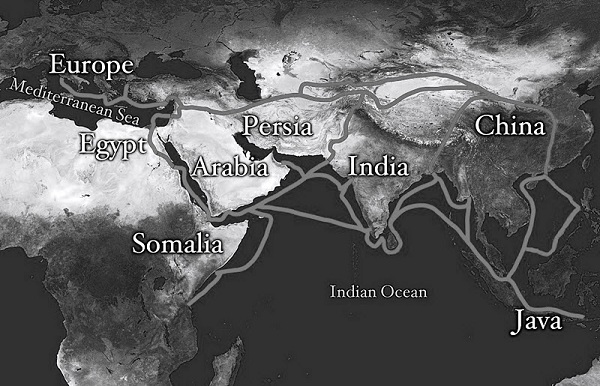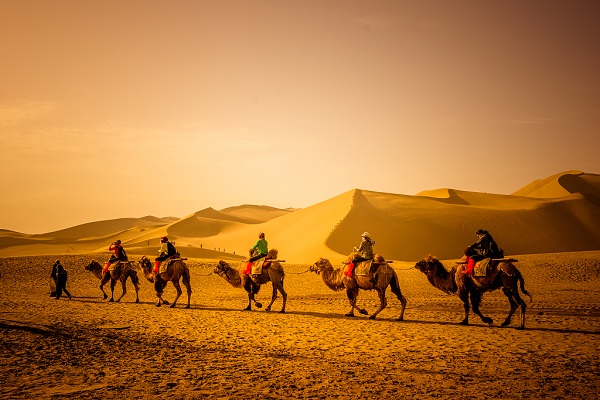Things you need to know before Silk Road adventure

The Silk Road was a historically important international trade route between China and the Mediterranean, connecting the East and the West in ancient and medieval times. Because Chinese silk comprised a large proportion of the trade along this ancient road, in 1877 it was named the Silk Road by Ferdinand von Richthofen, an eminent German geographer.
The Silk Road involved three continents: Europe, Africa and Asia.

The route began at Chang’an (now Xi’an), then through the Hexi Corridor it reaches Dunhuang, where it was divided into three: the southern, central and northern routes. The three routes spread all over the Xinjiang Uygur autonomous region, and then extended as far as Pakistan, India and Rome.
From the time Zhang Qian pioneered the world-famous Silk Road during the Han Dynasty (206 BC-AD 220) until the collapse of the Yuan Dynasty (1271-1368), the road enjoyed a history of about 1,600 years.

The road was not only an ancient international trade route, but also a splendid cultural bridge linking the cultures of China, Central Asia, India, Persia, Arabia, Turkey, Greece and Italy. The Four Great Inventions of China and the religions of the West were introduced to their counterparts along the Silk Road.
The scenery and sights along the Silk Road are spectacular and intriguing. There are the well-known Mogao Caves (Mogao Grottoes) in Dunhuang, the bustling Sunday Bazaar in Kashgar and the exotic customs in Xinjiang Uygur autonomous region.
It is now included on UNESCO’s World Heritage List. There are 33 major historic sites along the road, with 22 of them in China’s Shaanxi, Henan and Gansu provinces and Xinjiang Uygur autonomous region.
Valid information
a)Language: While traveling along the road, visitors can encounter about 20 different nationalities (ethnic groups), some of which, like the Uygurs, Tibetans and Mongolians speak their own language and have their own writing. Cultural exchange was considered very important during the development of the new unified national economy, while some ethnic groups began learning Mandarin and adopted the lifestyle of the Han people (the major ethnic group in China).
b) Accommodation: The Silk Road spans most of China, from modern cities in Central China to isolated villages and towns in the remote west. Accordingly, accommodation along the route ranges from high standard luxury hotels to simple guesthouses. In cities like Dunhuang, Turpan, Kashgar, Urumqi and Lanzhou, visitors can enjoy high standard hotels. They all provide excellent conditions, all-round services, which are quite safe. But this kind of hotel is also the most expensive. Visitors on a tight budget may consider cheaper guesthouses, which equipped with simpler facilities and basic services. Most Chinese travelers use these guesthouses. In remote villages only simple and rough lodgings are available. These locations offer nothing but a simple room.
b)Food and drink: On the Silk Road travelers will easily notice the Islamic influence on eating habits in Northwest China. If you are puzzled by the names of dishes on the menu, remember that the best way to order is by pointing to what other patrons are having. Remember that pork is forbidden in Islamic food. Moreover, the various nationalities you encounter along the road have their own typical drinks and food. In restaurants, popular refreshments like Coca-Cola, beer and fruit juice are always available. You can also try local drinks like kumiss, frozen yogurt and tea with milk.
c)Recommended reading: The Silk Road – from Xi'an to Kashgar by Judy Bonavia explains the history, natural conditions, remains, cultures and other facts about the road. Lonely Planet China is a good travel guide that provides all-round information about the Silk Road and other areas in China.
FAQs about Silk Road travel
Why is it called ‘Silk’ Road?
China was the first country in the world to breed silkworms and produce silk fabric. This craft skill reached a fairly advanced level in the Zhou Dynasty (c.11th century–256 BC). As China’s major export to Europe and the representative handicraft of this ancient country, ‘silk’ was used to name this great route.
How to plan your Silk Road tour?
The Silk Road is a long route which covers several provinces and regions in China, from Xi’an in the east to Gansu province and the Xinjiang Uygur autonomous region in the west. If you want to explore China more deeply, you should travel to Dunhuang, Zhangye, Jiayuguan, Turpan, Kashgar and Urumqi to follow in the footprints of Marco Polo. This route may take about 15 days. If you have only one week of holidays, choose three famous cities to visit.
When is the best time to visit Silk Road?
Along the Silk Road route, Xi’an and Gansu province are suitable to visit all-year round. From May to October is the best time to visit Xinjiang region because the weather is mild.

(Reference according to silk-road.com)
MOST POPULAR
- 1 China Daily's 'Shopping in China' platform appeals to intl audiences
- 2 China updates Catalogue of Encouraged Industries for Foreign Investment
- 3 Policies concerning expats, foreign enterprises in December 2025
- 4 China becomes the world's fourth manufacturing power
- 5 China ascends global higher education ranking







